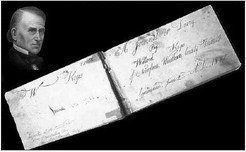Keyes gave up on property claim

“On the second day of June in A.D. one thousand eight hundred and seventeen, I, Willard Keyes, (being impelled by a curiosity, or desire of seeing other places than those in the vicinity of my Native town,) started from Newfane in Vermont intending to travel into the western parts of the United States.”
So begins the 222-page, handwritten journal of Willard Kimball Keyes, co-founder of Quincy and Adams County in the early 19th century, who had decided to seek his fortune in the West. Determined though he was, Keyes was sidetracked for two years by one of the greatest charlatans of early American history, the Rev. Samuel Peters of Hebron, Conn.
“The two greatest dishonors that ever befell Connecticut are the giving birth to Benedict Arnold and the Reverend Samuel Peters,” wrote Horace Bushnell, a Yale-educated theologian who despised Peters for his claim to be an Anglican priest and the doctor of laws degree that Peters conferred upon himself.
On June 9, 1817, one week after he began his journey west, the 25-year-old Keyes wrote that he had fallen in with a Constant A. Andrews. An associate of Peters, Andrews was bound for a 100-square-mile tract known as “Carver’s Purchase,” which covered most of the northwestern quarter of the modern state of Wisconsin. Peters had testified twice before Congress that Sioux Indians, whose ancestor-chiefs had deeded the land to Carver, “grunted and nodded over parchments” to prove he owned the land. Skeptical of Peters’ story, Congress offered to recognize the claim only if Peters could get descendants of the chiefs to agree.
Andrews told Keyes that he was traveling to meet Peters in York (now Toronto), Canada, for that purpose. He invited Keyes to join him as an agent for Peters.
Keyes’ journal entry the next day provides evidence that he was enamored by the offer. He rationalized a change of destination.
“I must now sit down and determine what course to pursue,” he wrote. “Swarms have been and are pouring from the nation’s hive (New England) to people the Western forests; it seems they have overstocked the market; for I daily meet those who are retracing their steps; they tell a discouraging story. . . . Mr. Andrews is solicitous to have me accompany him; and I am inclined to think I shall—” And he did.
Keyes and Andrews reached York on June 23, 1817, to await Peters. Still waiting a week later, Keyes was growing impatient. Andrews, who noticed his friend’s irritability, held his interest by executing a deed of 100 acres of land in the Carver tract to Keyes on June 30.
Peters arrived at York on July 2. “Dr. Peters is about 84 years of age,” Keyes wrote, “quite infirm, but says he will pursue his object of obtaining Carvers land till he obtains it. . . .”
Peters’ revelation that he would pursue the “land till he obtains it” should have informed Keyes that the 100 acres Andrews had given him carried a strong odor of fish. But Keyes was charmed by Peters.
On July 10, Keyes, Andrews and Peters set off for Mackinac in the Michigan Territory. Arriving on July 30, Keyes said all were disappointed and gave up the idea of forming a business there. Encouraged by Peters, the party set off for Prairie du Chien, 600 miles west in the Wisconsin Territory. It was from there that Carver had gone up the Mississippi River to St. Anthony where his purported acquisition occurred.
In August 1817, Keyes’ party reached Prairie du Chien, location of the wellprovisioned Fort Crawford. Col. Albert Chambers, the commanding officer refused to allow Peters to travel to St. Anthony. Chambers referred him to Ninian Edwards, governor of the Illinois Territory, which then included Prairie du Chien.
Peters waited nine months for the governor’s permission. When it had not come by May 1818, the old man set out for Washington to seek congressional permission. To assuage any doubts Keyes might have, Peters told him he “had private intelligence from several sources that are encouraging.”
Shortly after Peters left, Red Wing, a Sioux Indian, arrived in Prairie du Chien and confirmed to Keyes and Andrews that his ancestors had deeded the tract to Carver. Keyes and Andrews forwarded several reports to Peters, but the federal government refused to recognize them.
Keyes did become disillusioned with the Peters scheme.
By April 30, 1819, Keyes gave up. He launched a raft carrying himself and his few possessions.
“Leave Prairie du Chien, as I expect forever,” he wrote, “was obliged to sacrifice considerable property.”
The stillness of the river helped Keyes meditate on his adventure. He wrote stoically: “I have spent near two years at Prairie du Chien, with little satisfaction to myself; and perhaps as little acquisition of property. However, it is folly to mourn misspent time.”
In 1824, Congress ruled that Peters had no claim to the land. A congressional committee had found that Congress had passed no law to provide any land grants in the Wisconsin Territory. Peters’ enthusiasm, however, didn’t wane. When nephew Oliver Wolcott Jr., then the governor of Connecticut, pleaded in 1825 with his 90-year-old uncle to return to Hebron, where death had settled old scores, Peters rejected the idea.
“I’ll die first,” he spat. It was a promise kept within the year.






